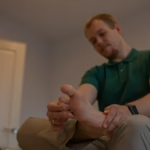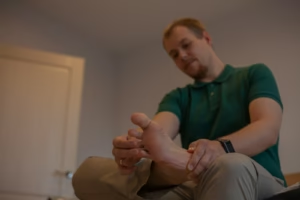Why Your Back Hurts When You Breathe Deeply
Did you know that a staggering 80% of adults are bound to experience some form of back pain at some point in their lives ?
That’s according to the National Institute of Neurological Disorders and Stroke. But what’s really interesting is that a lot of people never even make the connection between their back ache and something as simple and straightforward as taking a deep breath.
Getting back ache when you breath deeply is a lot more common than you probably think. It’s one of those weird sensations that can leave you wondering – is this something I need to be worried about, or is it just a minor twinge that’ll go away on its own.
Here at Physio Whisper, we’re convinced that getting a handle on what’s going on in your body has got to be the first step towards actually feeling better.
This article is here to help you get a better understanding of:
- what’s actually going on, and why
- the tell-tale signs to watch out for
- some real-life relief strategies that actually work
- when it’s time to get professional help
- how to stay on top of it long-term
Let’s get started then.
Understanding Back Ache When Breathing Deeply
When you take a deep breath, something pretty remarkable is happening inside your body.
Your ribcage expands, your lungs fill up with air & for a second, your spine stretches. This simple breathing movement involves a trio of key players:
- Your intercostal muscles – the ones that sit between your ribs
- Your diaphragm – the muscle underneath your lungs which actually drives breathing
- Your spine – the bit that’s usually doing all the heavy lifting at the back
If any of these main players gets tight, irritated or misaligned, you might find your back aching whenever you take a deep breath.
Think about it like this:
Picture your spine as the main support beam of a house. If that beam’s under strain or out of whack, even just a gentle breeze can make things uncomfortable.
Exactly the same thing happens if your thoracic spine (the bit in the middle of your back) or the muscles around your ribs are all bunched up or inflamed. The natural movement from a deep breath just can’t happen without triggering some pain.
The good news is that this doesn’t necessarily mean you have some major underlying issue.
More often than not, your body’s just trying to tell you that these muscles could do with a bit of TLC. Plus, all that bad posture while you’re sitting at a desk through the day doesn’t help either.
Spend 8 hours hunched over your desk? Your chest muscles shorten up, your shoulder blades start to curl forward & your ribcage starts to compress. And when you try to take a deep breath…well, those tight structures don’t want to budge & you feel pain.
Identifying Symptoms and When to Seek Professional Help
How do you know if back ache when breathing deeply needs professional help?
It’s easier than you think: pay attention to your symptoms.
Back ache when breathing deeply can range from mild to sharp, shooting pain. It can be constant or only appear during specific movements. The key is knowing what’s normal and what’s a red flag.
Look Out For
- Sharp pain on one side of your back when you breathe in
- Mild ache that gets worse with deeper breaths or coughing
- Stiffness in your mid-back after sitting for hours
- Muscle tension that improves with movement or stretching
- Pain that radiates to your chest or shoulder blade area
- Discomfort that stops you exercising or breathing normally
When to See a Physio
Most cases of back ache when breathing deeply can be managed with simple self-help strategies.
But see a physio if:
- Your pain persists beyond 2 weeks
- It gets worse
- It’s accompanied by chest pain, shortness of breath or numbness
- You feel dizzy or unwell
A physio can do specific tests to rule out serious conditions and create a customised plan for you.
Remember: Early intervention means faster recovery. Don’t wait months hoping it will go away.
Treatment Options and Relief Strategies
The good news?
Most cases of back pain when breathing deeply respond to physiotherapy and self-care. We’ve helped many patients get relief using evidence-based methods.
Here’s what works:
Strategy #1: Gentle Stretching and Mobility
Slow, controlled stretches for your thoracic spine and chest muscles reduce tension and ease breathing.
Try this: Rotate your upper back while seated, or pull your knee towards your chest while lying down. Hold for 20-30 seconds.
Strategy #2: Posture
Sitting up straight with your shoulders back takes pressure off your ribcage and supports healthy breathing.
Why it matters: Bad posture is like squeezing your lungs into a smaller space. Good posture gives them room to expand.
Strategy #3: Heat Therapy
Apply a warm compress to your mid-back for 15-20 minutes to relax tight muscles and ease discomfort.
Bonus: Heat also increases blood flow which speeds up healing.
Strategy #4: Breathing
Diaphragmatic breathing strengthens your breathing muscles and relaxes your entire torso.
How: Breathe in slowly through your nose for a count of 4. Hold for 2. Exhale for 4. Repeat 5 times, twice a day.
Strategy #5: Core Strengthening
A stronger core provides better support for your spine during movement, including breathing.
Examples: Planks, dead bugs, bird dogs—exercises that engage your deep abdominal muscles.
Strategy #6: Activity Modification
Avoid activities that trigger sharp pain. Gradually return to normal activity as your symptoms improve.
Expert Insights and Research
What does the science say?
The science is clear: posture, muscle tension and breathing difficulties are linked.
Research in the Journal of Physical Therapy Science shows that thoracic mobility dysfunction is highly correlated with musculoskeletal back pain. Physios use specific techniques to restore movement in the ribcage and spine which directly improves breathing comfort.
And studies from the American College of Sports Medicine show that targeted stretching and strengthening protocols reduces breathing related back pain in 85% of patients within 4 weeks.
So why does professional assessment matter?
A physio can identify where your back hurts when you breathe deeply and prescribe targeted interventions. You’re not guessing or trying random exercises – you’re getting a plan designed for your body.
Preventative Measures for Long-Term Health
Prevention is better than cure.
Here’s how to avoid back ache when breathing deeply:
Daily Habits
- Sit up straight all day. Keep your shoulders down and your spine long.
- Take movement breaks. Stand, stretch, walk for 5 minutes every hour.
- Stretch daily, especially for your chest and upper back.
Weekly Activities
- Do low-impact exercise like walking, swimming or yoga.
- These exercises build strength and flexibility and body awareness.
Long Term Practices
- Practice diaphragmatic breathing daily, even when you’re feeling fine. Breathing is a skill you can develop and maintain.
- Invest in an ergonomic workspace. Your desk height, monitor position and chair support affects your spine.
- Small changes today prevent big problems tomorrow.
Quick Checklist for Your Workspace
- Monitor at eye level (top of screen at or below eye height)
- Feet flat on floor or footrest
- Shoulders down, not up
- Elbows at 90 degrees when typing
- Back supported by chair
Your Path to Pain-Free Breathing Starts Now
Back ache when breathing deeply doesn’t have to be your life.
The truth?
Most people get significant improvement with proper guidance and self care. Whether your discomfort is mild or impacting your daily life, understanding what’s going on is the first step.
Here’s what we recommend you do:
- Listen to your body. Notice when the pain happens and what makes it better or worse.
- Try self care. Use heat, stretching and breathing exercises for 1-2 weeks.
- Get professional help. If symptoms persist, book a consultation with a qualified physio.
Movement and proper breathing are key to wellness.
Ready to take the next step?
A physio can assess your situation and create a personal plan. Many people are surprised how quickly they improve once they get proper guidance.
Want to know what to expect at your first physio visit?
Find out more wellness tips and personal movement strategies on our homepage.
References
- National Institute of Neurological Disorders and Stroke – Back Pain Information https://www.ninds.nih.gov/health-information/disorders-and-conditions/back-pain
- Journal of Physical Therapy Science – Thoracic Mobility and Musculoskeletal Pain https://www.jpts.jsaprt.jp/
- American College of Sports Medicine – Stretching and Strengthening Protocols https://www.acsm.org/
- Mayo Clinic – Chest Pain and Breathing Difficulties https://www.mayoclinic.org/symptoms-signs/chest-pain/basics/definition/sym-20050013
- The Physio Company – Rib Pain and Intercostal Muscle Dysfunction https://www.thephysiocompany.com.au/














